Electrostatic Potential and Capacitance - Online Test
Q1. If the charge on a capacitor is increased by 2 coulomb, the energy stored in it increases by 21%. The original charge on the capacitor (in coulomb) is
Answer : Option B
Explaination / Solution:
The initial energy of the capacitor of capacitance C and charge Q1 is .When the charge increases to Q2 the energy of the capacitor Given percentage increase of energy
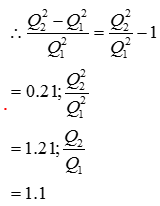
. But Solving

. But Solving
Q2. A parallel plate capacitor of capacity 100 μF is charged by a battery of 50 volts. The battery remains connected and if the plates of the capacitor are brought closer so that the distance between them becomes half the original distance, the additional energy given by the battery to the capacitor in joules is:
Answer : Option C
Explaination / Solution:
Initial energy of the capacitor. When the plates are kept at half the original distance, the new capacitance
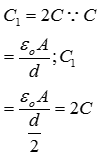
Final energy Increase in energy = additional energy given by the battery=
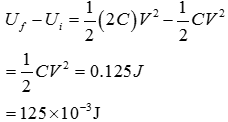

Final energy Increase in energy = additional energy given by the battery=

Q3. 64 water drops having equal charges combine to form one bigger drop. The capacitance of the bigger drop, as compared to that of smaller drop will be
Answer : Option D
Explaination / Solution:
Capacitance of the small drop of radius r and that of the big drop of radius R is The volume of 64 small drops = volume of 1 big dropThe ratio
Q4. Four capacitors, each of capacitance 50 are connected as shown in the figure. If the voltmeter reads 100 V, the charge on each capacitor is


Answer : Option D
Explaination / Solution:
PD across each 50μF capacitor is 100 V ( reading of the voltmeter.)
Q5. Three condensers of capacity 2 μF , 4 μF and 8 μF respectively, are first connected in series and then connected in parallel. The ratio of the equivalent capacitance in the two cases will be
Answer : Option D
Explaination / Solution:
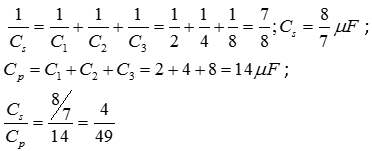

Q6. A capacitor of capacitance C = 2 is connected as shown in the figure. If the internal resistance of the cell is 0.5, the charge on the capacitor plates is
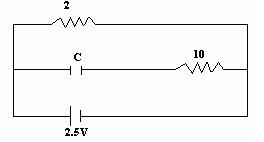

Answer : Option C
Explaination / Solution:
At steady state no current flows through the capacitor. The total resistance in the circuit =2+0.5=2.5Ω. Current I=V/R=2.5/2.5=1A. since no current flows through the 10 Ω resistor, the potential drop across it =0. The potential drop across the 2 Ω resistor = potential across the capacitor= I×2=2V.Charge on the capacitor Q= CV=(2μF)×(2V)=4μC.
Q7. Two parallel plate capacitors of capacitances C and 2C are connected in parallel and charged to a potential difference V by a battery. The battery is then disconnected and the space between the plates of capacitor C is completely filled with a material of dielectric constant K = 3. The potential difference across the capacitors now becomes
Answer : Option D
Explaination / Solution:
The charges on the capacitors after being charged to a potential V are.After being filled with a material of dielectric K=3 the capacitor which initially had a capacitance C has now the capacitance KC=3C. The common potential


Q8. In the network shown in the figure, C1 = 6 and C = 9 . The equivalent capacitance between points P and Q is
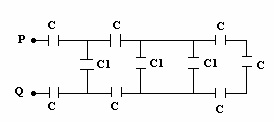

Answer : Option B
Explaination / Solution:
The circuit is reduced as follows: The capacitances are in micro farads.
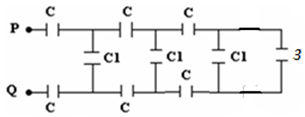
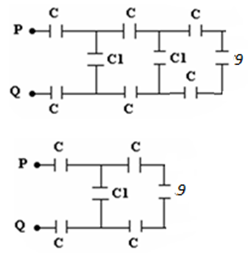
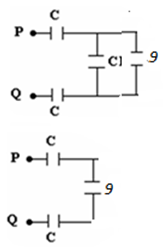
The capacitance between P and Q is 3μF



The capacitance between P and Q is 3μF
Q9. Three capacitors, each of capacitance C = 3 mF, are connected as shown in the figure. The equivalent capacitance between points P and S is
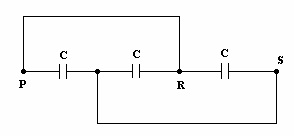

Answer : Option A
Explaination / Solution:
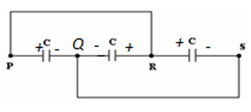
If P is at positive potential, then Q is at negative potential and R is at positive potential. The system therefore reduces to 3 capacitors in parallel. C= 9μF

If P is at positive potential, then Q is at negative potential and R is at positive potential. The system therefore reduces to 3 capacitors in parallel. C= 9μF
Q10. A parallel plate air filled capacitor shown in the Fig. (a) has a capacitance of 2 . When it is half filled with a dielectric of dielectric constant k = 3 as shown in Fig. (b), its capacitance becomes


Answer : Option D
Explaination / Solution:
The capacitance of the first capacitorThe second capacitor is considered to be made of two capacitors C1( air filled) and C2( dielectric) connected in series.
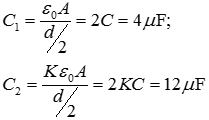
The equivalent capacitance


The equivalent capacitance

